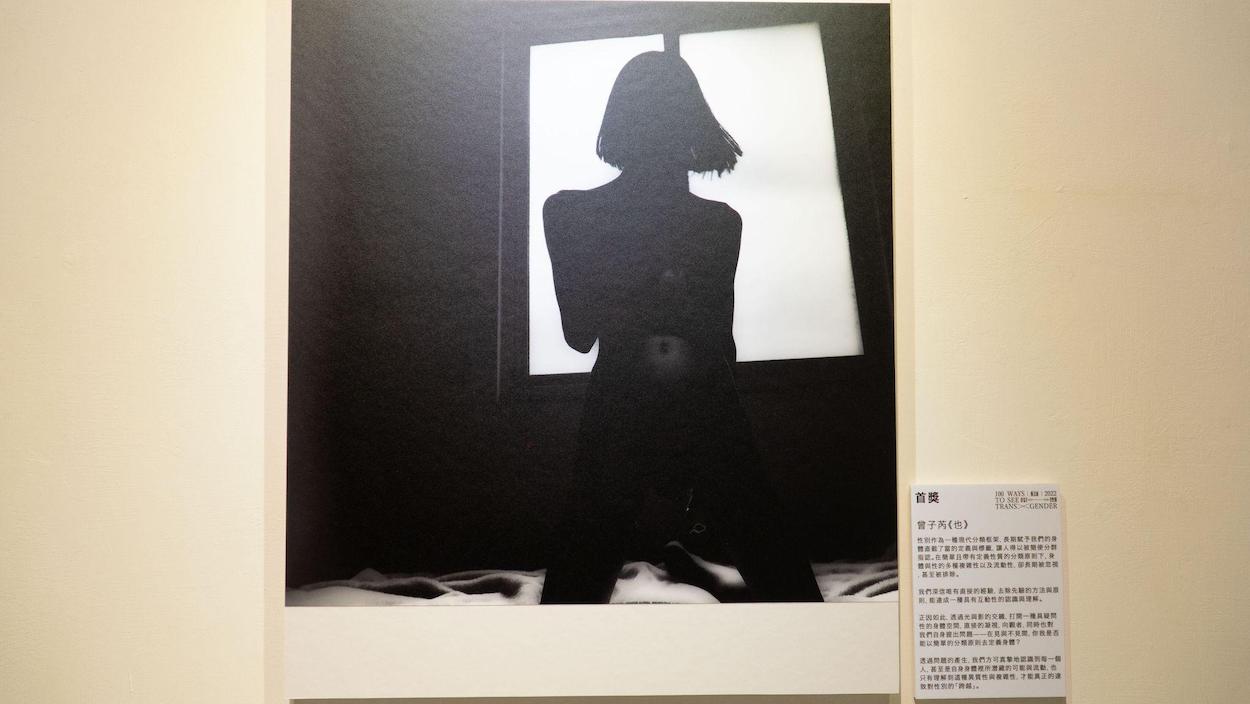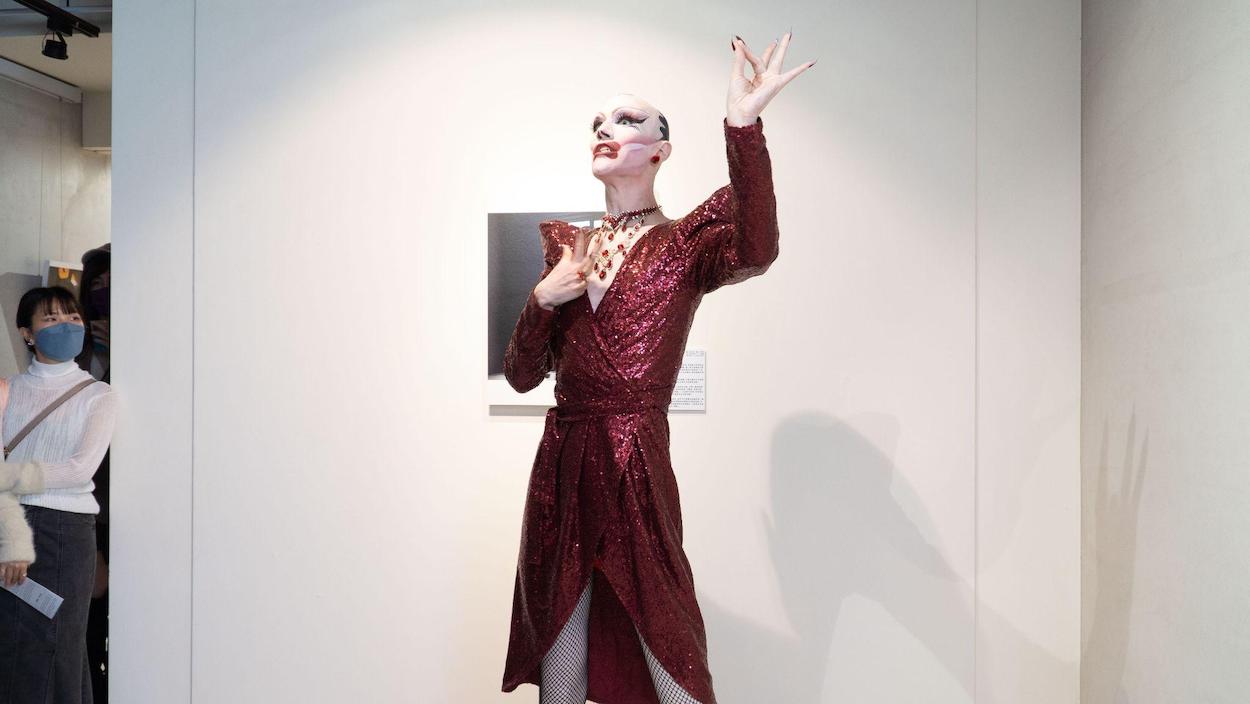by Daniel Yo-Ling
語言:
English
Photo courtesy of TAPCPR
THIS PAST WEEKEND, over 200 participants came to see the Taiwan Alliance to Promote Civil Partnership Rights’ (TAPCPR) “看見跨性別藝文展 100 Ways to See Transgender” exhibition at 二空間 SPACE TWO. Since their first Transgender Film Festival in 2020, TAPCPR has made it a tradition to do larger scale public engagement programming around transgender issues every year in the month of November. Last year was the second Transgender Film Festival, and this year is the 100 Ways to See Transgender exhibition.
100 Ways’ curation team selected 13 photography submissions featuring various visual meditations on the lives of transgender and gender diverse peoples in Taiwan. These photographs ranged from the everyday dilemma of a transgender man caught in the dilemma of which public restroom to use to the exhausted elation of a young transgender women who, after six months of lobbying, was finally being able to convince her school administrators to allow her to graduate as a female student. As part of this exhibition, submissions were also ranked by the curation team and awarded prizes. The exhibits first place prize went to photographer 曾子芮’s piece,《也》(“Also”), which features 安東. Second place went to photographer Tyson Skriver’s piece, 《Free 自由》, a portrait shot of Birdy, with third place going to Wi’s《Define Yourself》. Overall, the 13 submissions that make up the majority of 100 Ways were well curated and covered a range of transgender experiences.

“100 Ways to See Transgender” exhibition first place winner《也》(“Also”) by 曾子芮. Photo credit: 強納森 Alex “Jonathan” Huang.

“100 Ways to See Transgender” exhibition third place winner《Free 自由》by Tyson Skriver. Photo credit: 強納森 Alex “Jonathan” Huang.
 “100 Ways to See Transgender” exhibition third place winner《Define Yourself》by Wi. Photo credit: 強納森 Alex “Jonathan” Huang.
“100 Ways to See Transgender” exhibition third place winner《Define Yourself》by Wi. Photo credit: 強納森 Alex “Jonathan” Huang.
100 Ways also included a special exhibit section for Hong Kong transgender advocacy organization the Association of World Citizens Hong Kong China (AWCHK) to display their photography album project “跨卓 Transcendence,” which features 11 local transgender subjects from Hong Kong. AWCHK launched an electronic version of Transcendence last year, so for the Taiwan debut of this album, AWCHK partnered with TAPCPR to do an exclusive 300 copy printing of Transcendence, which was distributed for free as part of the 100 Ways exhibit. AWCHK founder Mimi Wong also visited Taiwan to attend the 100 Ways exhibit throughout the weekend. On the last day of the exhibit, Wong offered a few remarks about the founding of AWCHK and how the Transcendence photo album project came to be. She mentioned that she felt honored to have Transcendence be part of the 100 Ways exhibit and thanked TAPCPR and attendees for helping to share with the world that “transgender women are women, and transgender men are men.”
 AWCHK founder Mimi Wong offers remarks in front of the Transcendence special exhibit section of 100 Ways. Photo credit: Daniel Yo-Ling
AWCHK founder Mimi Wong offers remarks in front of the Transcendence special exhibit section of 100 Ways. Photo credit: Daniel Yo-Ling
In addition to the visual pieces on display, TAPCPR also planned a series of public events throughout the weekend as part of the 100 Ways exhibition. These included two lectures, two screenings of Christina Willing’s short documentary Beauty, which explores the lives of five transgender and gender diverse children, two Human Library event featuring transgender and non-binary speakers, and a special performance by New Zealander Nick van Halderen’s dragqueen personality, Taipei Popcorn.

Photograph of Popcorn during the 100 Ways exhibit. Photo credit: 強納森 Alex “Jonathan” Huang.
On Saturday, Tsing Hua University professor Chia-Hsien Yang (楊佳嫻) gave a lecture on transgender representation in Taiwanese literature. Notably, Professor Yang’s lecture introduced audience members to the work of contemporary transgender poet 柴柏松’s 2020 poetry collection《許多無名無姓的角落》. On Sunday, Shih Hsin University professor Pei-Wen Lee (李佩雯 gave a very pragmatic lecture on how to communicate and engage in civil discourse around transgender issues, especially given increasing public controversy over trans rights in Taiwan.
 Photograph of Professor Chia-Hsien Yang. Photo credit: 強納森 Alex “Jonathan” Huang.
Photograph of Professor Chia-Hsien Yang. Photo credit: 強納森 Alex “Jonathan” Huang.

Photograph of Professor Pei-Wen Li. Photo courtesy of TAPCPR.
Perhaps the most memorable part of 100 Ways were the two Human Library events held on the evenings of Saturday and Sunday. Together, these two sessions featured the life stories of three transgender women, two transgender men, and one non-binary person. These life stories help to further attendee’s understanding of the diversity of transgender experiences. For instance, one transgender man shared about how, still in his 20s, he has yet to make a decision on whether he wants to maintain his reproductive capacity, but since Taiwan’s existing laws prevent him from updating his legal gender without providing proof of surgery that effectively amounts to forfeiting his reproductive capacity, he has to frequently navigate being misgendered on the phone when called by utility companies and telemarketers, as well as being subjected to invasive “extra precautionary measures” when passing through security at the airport.
Another Human Library participant, a transgender woman who has already fully socially transitioned without the use of hormones or surgeries, shared about a traumatizing experience she had being denied a job because her potential employer thought that company clients would be unaccepting of her transgender status, but how she nevertheless was able to move on from this experience to pursue her career as a therapist. She also emphasized that representations of transgender joy are also a very important part of trans life narratives, sharing how her love of vogueing has helped her throughout her journey.
100 Ways Human Library events also included the life story of a non-binary person. This participant originally identified as a lesbian for the majority of their life but eventually came to identify as non-binary because the term felt more encompassing of their life experiences. For instance, they shared about disliking gendered parts of their body and engaging in chest binding. However, they have come to accept their body more as they grew older and even enjoy parts of themselves that would traditionally be considered feminine such as having supple skin and a softer voice.
Overall, 100 Ways programming ensured continuous circulation of new crowds into the exhibit, with total foot traffic reaching over 200. While the exhibit itself was relatively small, taking less than an hour to work through all the pieces, it was nevertheless highly successful in increasing public engagement with transgender issues in Taiwan. Furthermore, the exhibit as a whole–the selected submissions, screenings, public lectures, dragqueen performance, and Human Library events–provided audiences with a broad swath of transgender and gender diverse stories and life experiences. As Taiwan continues its push for transgender rights, the nuanced treatment of transgender lives evident throughout the 100 Ways exhibit have never been more necessary.

Timeline of transgender advocacy in Taiwan displayed as part of the 100 Ways exhibit. Photo credit: Daniel Yo-Ling
Afterword: If you enjoyed this piece and appreciate the work that TAPCPR is doing to advocate for transgender rights in Taiwan, please consider donating to them through either their international donations page (in English) or domestic donations page (in Mandarin).



